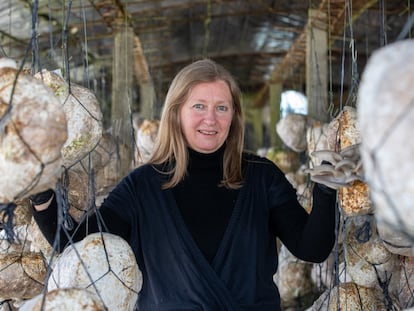New technique discovers that plastic bottles contain thousands of nanoparticles capable of infiltrating cells
A system developed by researchers at Columbia University makes it possible to detect individual fragments smaller than microplastics and with unknown effects on health

In recent years, numerous studies have found traces of plastic in the most remote places in the world, including both polar circles. Concern about this type of pollution has led to bans on things like plastic cutlery and glitter. This material not only contaminates in its complete form as objects that take centuries to break down, but also when smaller particles are released from it. So far attention has been focused on microplastics, fragments ranging from five millimeters to one millionth of a meter, which is 50 times thinner than a human hair. But it is known that plastic can continue to divide into even smaller fractions, almost to infinity.
Nanoplastics, up to a billionth of a meter, are so small that they can pass through all human tissues, travel through the bloodstream and reach the brain or the placenta of pregnant women. Although there is concern about its health effects, studies are still in the early stages and even knowledge about its presence is limited. This week, researchers from Columbia University published an analysis in the journal PNAS in which they studied whether there were nanoplastics in bottled water, what type and in what amounts. Using a technique called hyperspectral stimulated Raman scattering (SRS) imaging, co-invented by Wei Min, the co-author of the study, they detected that, on average, about a quarter of a million of these plastic pieces could be found in each liter of bottled water.
One of the most frequent components found among these nanoplastics was PET (polyethylene terephthalate), the material from which plastic bottles are usually made. According to the authors of the study, these particles can be released when the bottles are heated, when they are squeezed or when the cap is opened and closed. However, polyamide was more abundant, a type of nylon that, according to co-author Beizhan Yan in a statement from Columbia University, probably comes from the plastic filters used before bottling the water, supposedly to purify it. The rest of the most common materials found are usually used in various industrial processes related to bottling.
“Methods had been developed to see nanoparticles, but [researchers] did not know what they were looking at,” explains Naixin Qian, co-author of the study. With the new method, they have been able to observe the quantities of nanoparticles from seven types of ordinary plastics and count them individually. However, this selection only represents 10% of the particles found. It is not known if the rest are remains of plastic or other types of particles, evidencing how complicated it is to analyze such tiny compounds and how much is still unknown about the composition of many things we consume.
A review of studies published in January by eBioMedicine notes that increasing evidence suggests exposure to microplastics and nanoplastics can have negative effects on various human organs. However, the authors point out that the mechanisms by which these effects could occur, or whether long-term exposure to these particles increases the risk of disease, are unknown issues. In general, although the effects of some specific particles have been studied to evaluate their toxicity, there are many which, as this study shows, are abundant in commonly consumed products or in the environment, and which have not been studied in detail. The authors of the work, led by Jorge Bernardino de la Serna from Imperial College London, state that future studies should investigate exposure to micro- and nanoplastics, considering realistic concentrations, the susceptibility of each individual to these substances and the necessary dose to have a significant negative effect.
The authors of the PNAS study now want to use their technique to analyze tap water, where, in a much lower concentration than in bottled water, microplastics have also been found. In a world where nearly 400 million tons of plastic are produced each year and the material is used to make almost everything, there are endless opportunities for plastic nanoparticles to continue to be released and dispersed throughout the environment or integrate into the tissues of living beings. Identifying more precisely the quantities and composition of these particles is a step to evaluate the dimension of the problem, its possible effects on health, and to begin to think about ways to reduce potential threats.
Sign up for our weekly newsletter to get more English-language news coverage from EL PAÍS USA Edition
Tu suscripción se está usando en otro dispositivo
¿Quieres añadir otro usuario a tu suscripción?
Si continúas leyendo en este dispositivo, no se podrá leer en el otro.
FlechaTu suscripción se está usando en otro dispositivo y solo puedes acceder a EL PAÍS desde un dispositivo a la vez.
Si quieres compartir tu cuenta, cambia tu suscripción a la modalidad Premium, así podrás añadir otro usuario. Cada uno accederá con su propia cuenta de email, lo que os permitirá personalizar vuestra experiencia en EL PAÍS.
¿Tienes una suscripción de empresa? Accede aquí para contratar más cuentas.
En el caso de no saber quién está usando tu cuenta, te recomendamos cambiar tu contraseña aquí.
Si decides continuar compartiendo tu cuenta, este mensaje se mostrará en tu dispositivo y en el de la otra persona que está usando tu cuenta de forma indefinida, afectando a tu experiencia de lectura. Puedes consultar aquí los términos y condiciones de la suscripción digital.
More information
Últimas noticias
The open war against the oil ‘phantom fleet’
‘Sleepless City’: The light of cinema illuminates Madrid’s Cañada Real shantytown
Christmas loses its festive spirit: ICE fears cast shadow over religious celebrations
Russell Tovey: ‘I was advised many times not to come out, I don’t think there was many people who’d done that — and I feel really proud that I’m one of those that did’
Most viewed
- Families demand repatriation of bodies of Colombians who died in Ukraine: ‘This war is a slaughterhouse for foreigners’
- The low-cost creative revolution: How technology is making art accessible to everyone
- Liset Menéndez de la Prida, neuroscientist: ‘It’s not normal to constantly seek pleasure; it’s important to be bored, to be calm’
- Christian Louboutin: ‘Young people don’t want to be like their parents. And if their parents wear sneakers, they’re going to look for something else’
- ‘El Limones’ and the growing union disguise of Mexican organized crime











































